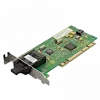FDDI stands for Fiber Distributed Data Interface. It is a high-speed networking technology that was developed in the 1980s as a standard for transmitting data over fiber optic cables. FDDI was primarily designed for use in enterprise and backbone networks, offering reliable and fast data transmission.
FDDI operates at a speed of 100 megabits per second (Mbps) and uses a dual-ring topology. This means that data is transmitted in two counter-rotating rings, providing redundancy and fault tolerance. If one ring fails, the network traffic automatically switches to the other ring, ensuring continuous connectivity.
The FDDI standard supports both single-mode and multimode fiber optic cables, providing flexibility in terms of the network's distance and bandwidth requirements. It also incorporates features such as token passing access control and fault detection mechanisms to ensure reliable data transmission.
FDDI was widely used in the 1990s for high-speed LANs and backbone networks. However, with the rise of Ethernet and other technologies, FDDI has become less prevalent in modern network infrastructures. Nonetheless, its legacy and principles have influenced subsequent networking standards and technologies.
